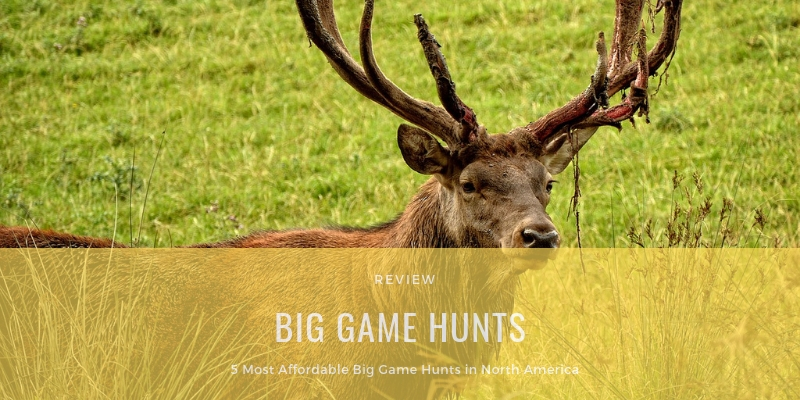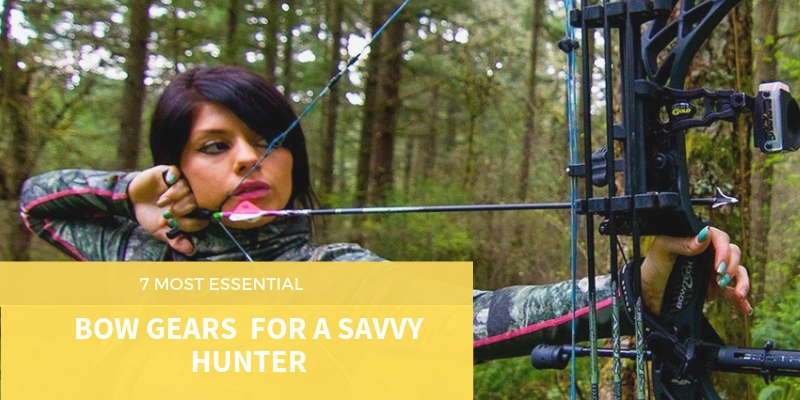Scrambling hard and fast, I’d managed to get ahead of the bear, and now he was slowly making his way in my direction. Cover and terrain hid him from me for long seconds, and my palms sweated as I gripped the rifle, waiting.
Then he was there. Not just close enough, but too close. I raised the rifle, saw little more than fur in the scope, and squeezed the trigger . . .
Wait.
We’re missing some details.
What kind of bear? What was the terrain like? Was it a big bear?
The scenario above has happened to me three or four times. Once it was with a large brown bear in snow-covered alders; several other times this has happened with black bears in areas as diverse as North Carolina and Alaska.
Let’s try again.
The bear was feeding in a little clearing on a brushy hillside. We’d glassed him from afar and had the drop on him, but the brush and terrain were such that a 200-yard shot was the best we could do. I set up my daypack over a handy boulder, laid the rifle across it and took some deep breaths while I waited for the bear to turn. When the shot looked right, I squeezed the trigger.
This second scenario has repeated itself with Alaskan brown bears, mountain grizzlies and quite a number of black bears. For various reasons, a steady, deliberate shot at 200 yards seemed the right thing to do.
There are two important points here. The main one is that, regardless of which bear you are hunting or where you are hunting him, it is difficult to predict exactly what kind of shot you will draw. You need to be ready for anything from a fast shot at bayonet range to a precise, deliberate shot at something beyond 200 yards–or anything in between. The other important thing is that, with minor variations, the two opposite scenarios described above accurately describe circumstances under which I’ve taken two coastal brown bears, two grizzlies and at least eight black bears. In other words, the prospective bear hunter should be prepared for either extreme.
These two scenarios combine genuine incidents with about a dozen different bears, and in all cases I was successful. Not all resulted in one-shot kills, but in no case did we have to chase a wounded bear. I have also taken a lot of bears in the “middle ground” between, say, 50 and 175 yards–and in that middle ground I have screwed up, sometimes badly. But at the two extremes, very close and much farther out, I have been quite successful. This suggests I have used rifles and cartridges that would handle any shot I might encounter, and that’s really what selecting guns and loads for game is all about.
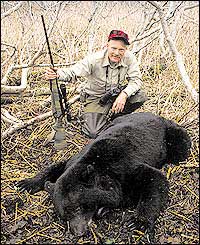
Bears, all bears, are powerful animals that demand your respect, and since big bullets just plain hit harder than smaller bullets, that’s the way to go.
|
BIG BEAR, BIG BULLET
We tend to dwell on foot-pounds when considering a cartridge’s suitability for game. But bears, like Cape buffalo, don’t understand foot-pounds of energy and aren’t particularly impressed by them. Any bear, is an extremely powerful animal whose vitals are well-shielded by tough hide, corded muscles and heavy bones. The problem multiplies exponentially as bears get bigger, so you must use bullets that are tough and will penetrate without fail. The only way to kill a bear is to place the shot so that it will do extensive and irreparable damage to the heart, lungs, spine or brain.
Because of this, I believe in fairly large bore diameters and heavy-for-caliber bullets. If I were to quantify “bear medicine” in terms of foot-pounds, I would rate black bears about the same as elk: I want a good 2,000 ft.-lbs. of energy. On the largest bears, 3,000 ft.-lbs. is a good number–provided you place your shot and use a proper bullet.
I’m still haunted by the handful of lost-game incidents I’ve experienced in my career, even though a couple of instances go back 30 years or more. I can relate two instances of wounded and lost bears. One was not mine; the rifle was a .270, the bullet a 150-grain conventional softpoint. The presentation was straight broadside, and through the binoculars I saw the impact on the shoulder. From the bear’s reaction, and the trail we followed until it ran out, the only possible conclusion is that the bullet failed to penetrate the heavy shoulder bones.
The second instance was mine. I shot a huge brown bear–supposedly on the shoulder–with a 180-grain X-Bullet from a .300 Win. Mag. The bear instantly lurched into the brush, and we followed an ever-diminishing spoor for eight hours, failing utterly when we tried to pick it up again the next day.
There are lessons here, but don’t take home the wrong ones. In the first case, the .270 will surely kill black bears, and the 150-grain bullet is the right weight–but on bears you’d better make it a premium bullet that will surely penetrate: Fail Safe, Barnes X, Trophy Bonded Bearclaw, Swift A-Frame, Nosler Partition and the like.
In my own debacle, the .300 Win. Mag. was enough gun, and the Barnes X was surely enough bullet. The simple answer is that I flubbed a simple shot. It is almost certain I didn’t hit the bear where I thought I did because he was seen the next season hale and hearty. I will always wonder if a bigger rifle like a .375 might have dealt a heavy enough blow to give me time for a second shot, but the fact remains that a bigger gun won’t help if you miss the mark.
Big Game
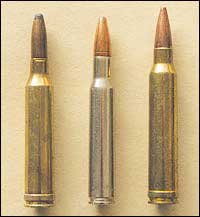
Versatile, dependable cartridges such as (from left) 7mm Rem. Mag., .30-06 and .300 Win. Mag. will work for all black bear hunting.
|
VERSATILITY
You want plenty of power behind good bullets, and in most situations you also want versatility. The big bears–brown/grizzly and polar bears–are properly considered dangerous game. Black bears are borderline, but far more people are mauled by black bears annually than by all the rest combined. With any bear it is essential that you be able to stop the animal at close range, whether in a chance meeting or a genuine charge. But it is also desirable that you be able to reach out at least 200 yards, preferably 250 yards, because that might be the only opportunity you have.
This business of reach is actually a dual requirement. First, the cartridge should be flat-shooting enough so that you can make a shot at medium range without worrying about holdover. Second, the cartridge must have enough power so you still have all the energy and penetration you need when the bullet gets there.
There are at least two common exceptions to this versatility business: black bears over bait and hunting with hounds. In the former, you can forget about 200-yard shots–most stands for rifle hunting are sited 50 to 100 yards from the bait. Baiting is usually done in timber, so unless the first shot immobilizes the bear, he can vanish before a second shot is remotely possible. Of course, black bears are most likely to come to the bait in the evening, and the biggest bears will usually appear very late, in poor shooting light. All of this points to a rifle that will thump a bear really hard, and this is a perfect place for a powerful “brush rifle” like a Marlin in .45-70 or .450 Marlin, or a Marlin or Winchester 94 in .444 Marlin.
Hunting behind hounds is a different game. The chase will often take you through some of the steepest and nastiest country around, so gun weight and handiness are factors. When the bear is bayed or treed, the shot will almost always be at short range, but it’s essential that the bear be taken as cleanly as possible to prevent injury to the dogs. The classic houndsman’s rifle was the short, light, vicious-kicking Remington M600 in .350 Rem. Mag., discontinued many years ago. Other good choices include lever actions from .35 Rem. upwards, and this would be a good place for Ruger’s slick little .44 Mag. carbines in both lever action and semi-auto.
BLACK BEAR RIFLES
For all-around use on black bears, I still like fairly heavy calibers and heavy bullets, but I want a bit more range. My preference is medium-velocity .35 calibers. The nearly obsolete .358 Win. in a lever-action Winchester 88, Browning BLR or Savage 99 is good; when zeroed correctly, it will do just fine from the muzzle out to 250 yards or so.
However, the .350 Rem. Mag. (also almost obsolete) and the .35 Whelen are superior. Fortunately the Whelen is both popular and available, and I rate it as one of the best black bear cartridges in the world. This year, Weatherby will be producing the first factory rifles in the .338-06, long a popular wildcat, and this will be another excellent black bear cartridge.
There is nothing wrong with using your favorite deer rifle chambered to something between .270 and .30 caliber. I tend to lean toward the .30s, but a .270 or a 7mm will cleanly take bears. When you go lighter in caliber you must be even more careful to choose good, tough, heavy-for-caliber bullets that will penetrate. Round-nosed bullets initiate expansion and transfer energy far more rapidly than spitzers, and at closer ranges their ballistic inferiority isn’t important. If I were using a .270 on black bear I’d choose a tough 150-grain round-nose bullet. In the 7mms, use bullets from 160 grains upwards, and in the .30 calibers consider 180 grains the minimum weight.

Most bear hunting is down in relatively close cover, where trajectory isn’t critical. Here’s where power and placement come into play; you want to drop that bear quickly.
|
Bigger isn’t necessarily better, but there is absolutely nothing wrong with fast .33s from the .338 Win. Mag. upwards. I’ve often used a .375 H&H;, and I’ve never been embarrassed about carrying such a large rifle. In one of the close-encounter scenarios mentioned at the beginning of this story, I was using my 8mm Rem. Mag.; in another I was using a .375 H&H.; Neither instance was exactly a charge or an attack, but in both situations I shot monster black bears right off the end of the rifle barrel–and I was thankful I had plenty of gun in my hands.
THE BIGGEST BEARS
When I talk about cartridges for black bears, I’m always thinking about the kind of bear I hope to encounter: a bear weighing a quarter-ton or more. All bears are tough, but a 500-pounder is in a whole different class from the average bear, which will weigh closer to 200 pounds.
The potential for a really big bear exists wherever black bears are found, and a monster black bear will outweigh the average interior grizzly. Of course, grizzly bears get a whole lot bigger, and salmon-fed coastal brown bears and polar bears are larger still. Few brown bears are ever weighed, but I am absolutely certain that a really big one will go a good 1,500 pounds.
Shot placement remains the most important issue, but I think a .30-caliber firing a good 200-grain bullet is absolutely minimal. I can assure you that I will never again hunt a big bear with a caliber as light as .30. Good choices start with the 8mm Rem. Mag. and work their way through the magnum spectrum to about .416.
I think cartridges such as the .338 Win. Mag., .340 Wby. Mag. and .338 Rem. Ultra Mag are perfect for grizzly bears. Interior grizzlies are smaller than coastal bears, and the terrain often results in longer shots. Further, inland bears are far more thinly distributed than coastal bears, so while long-range shooting is not recommended, you want to be able to take any sensible shot. My last grizzly was killed on the final evening of the hunt, cross-canyon at about 250 yards; a 250-grain Nosler from my .340 Wby. Mag. flattened him.
The fast .33s are also good medicine for brown bears. Another of my close encounters was a Kamchatka brown bear that emerged from snowy alders at less than 60 yards. The same load from the same .340–just one–handled the situation perfectly. Even so, I lean heavily toward the .375 for the very largest of bears. The .375 H&H; is the traditional choice, but it’s hardly the only .375 out there. Faster cartridges such as the new .375 Ultra Mag and Weatherby’s soon-to-be-reintroduced .375 Wby. Mag. offer a bit more versatility without an inordinately high price in recoil.
There is simply no such thing as too much gun when hunting the biggest bears; many Alaskan guides carry .458s (and larger) with no apologies. However, there’s a difference between hunting a bear and preventing the escape of a wounded bear or stopping an attack. My idea of the ideal “big bear rifle” is bolt action, chambered to anything from a fast .33 to a .375, in either synthetic or laminate stock.alloutprodux.com
Expert Tips: Top Bear Hunting Rifles of All Time
If you are looking to take down a big bruin, there are some rifles that will make the most sense.
Ruger Hawkeye Alaskan (RHA) for Black Bear

Ruger Hawkeye Alaskan (RHA) rifles have been designed specifically with bears in mind and offer an effective way to deal with this animal under tough conditions.
The Ruger Hawkeye Alaskan (RHA) rifles have been designed specifically with bears in mind and offer an effective way to deal with this animal under tough conditions.
The Ruger Hawkeye Alaskan also has one of the best scopes available when it comes to taking down bruins with precision shot placement. This is important because you do not want a high caliber rifle which will only knock them out, but rather something that can take massive game like bear without any difficulty at all.
The Ruger’s stock is durable yet lightweight thanks to its composite construction which makes for easier carrying as well as fast shooting.
Rugers are powerful enough rounds so even on windy days, they still provide excellent shots far beyond normal.
Ruger Hawkeye Alaskan (RHA) rifles are available in Ruger calibers such as .300 Winchester Magnum, and Ruger’s own proprietary Grizzly Cartridge. One of these models would be perfect for hunting black bears.
Winchester Model 70 Alaskan as a Bear Rifle

Winchester Model 70 Alaskan is another excellent option as it has everything that makes it so effective on big game such as its accuracy, power and reliability with all types of ammunition including those being used by other manufacturers’ rifles.
Winchester M70 has the stainless finish and Ruger style action.
Winchester M70 Alaskan also has a beautiful walnut stock and is available in 20-inch barrel length, which offers the hunter more speed/energy options when it comes to their ammunition selection.
Remington Model 700 is Great for Brown Bear

Remington Model 700 is another excellent choice for brown bear hunting.
This rifle has a heavy barrel that improves bullet energy because it does not have to go as far to penetrate the animal at close distances, but also enough velocity and accuracy to make long-range shots on larger bears.
It’s no surprise this gun tops many hunters lists with its Ruger style action and easy bolt operation which makes reloading quick and accurate while in the field or standing over an animal after making your kill.
Remington offers several variations of their popular model including .270 Winchester, 30-06 Springfield, 338 caliber magnum models.
The latest version is now available in 300 Win Mag/300 Ruger Compact Magnum/.375 Ruger calibers as well.
Marlin 1895 Lever Gun for Bear and Big Game

Marlin 1895 lever gun is a great option for bear hunting and other big game hunting.
One of the distinctive features of this rifle is that it can be easily cocked by pulling back on the lever loop. It also has a very handy magazine tube loading system which allows you to load bullets one at a time or in batches, making reloading even faster and more convenient than Ruger’s Hawkeye Alaskan model.
This gun packs plenty of power with .450 Marlin being its most powerful caliber available for all-around use out west where bear are hunted as well as deer, elk and moose.
For Eastern hunters who want an all around accurate cartridge for their black bears hunts, there are many options including 30-30 Winchester/.35 Remington,.44 Magnum round etc…
Remington 870 is a Close-Range Bear Rifle
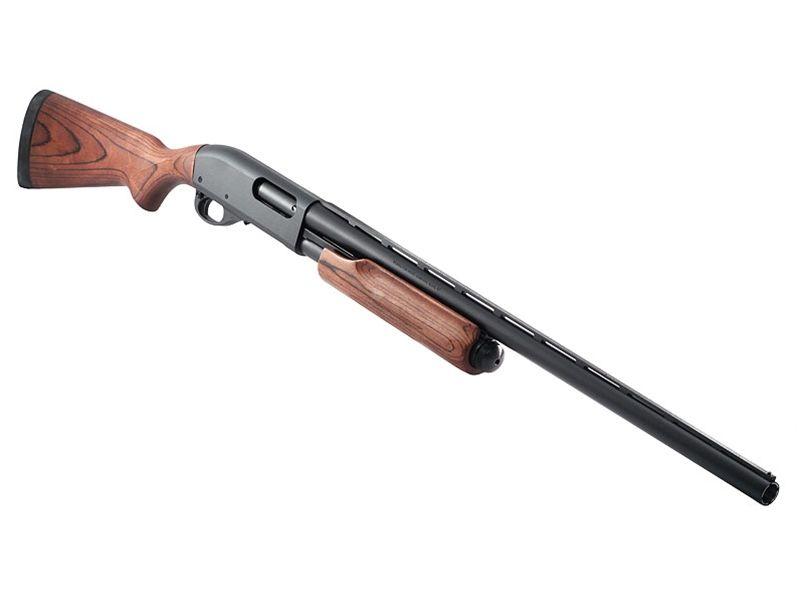
Remington 870 is a favorite defense bear gun for hunting that is used for close encounters. It’s a pump-action shotgun with the ability to use slugs and buckshot loads, but it also comes without any attachments.
Smith & Wesson 500 for Bear Defense
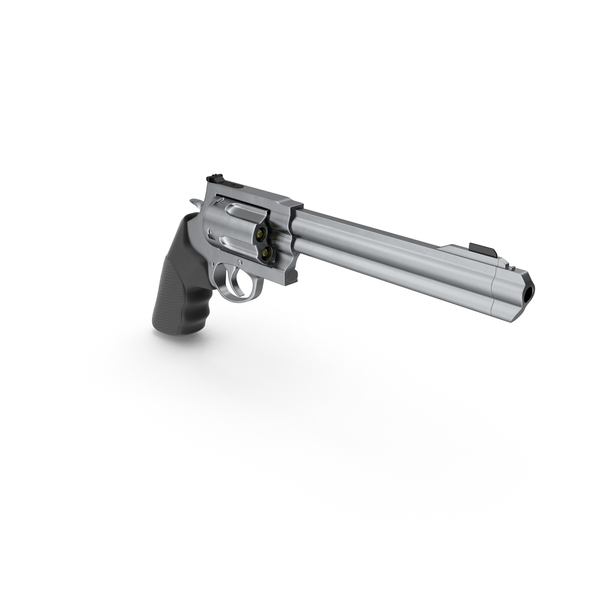
The Smith & Wesson 500 revolver was made specifically for home defense against aggressive ursines – its five rounds are enough fire power for stopping just about anything from 400 pounds up to 900 pounds.
Savage Axis XP 308 Hunting Rifle
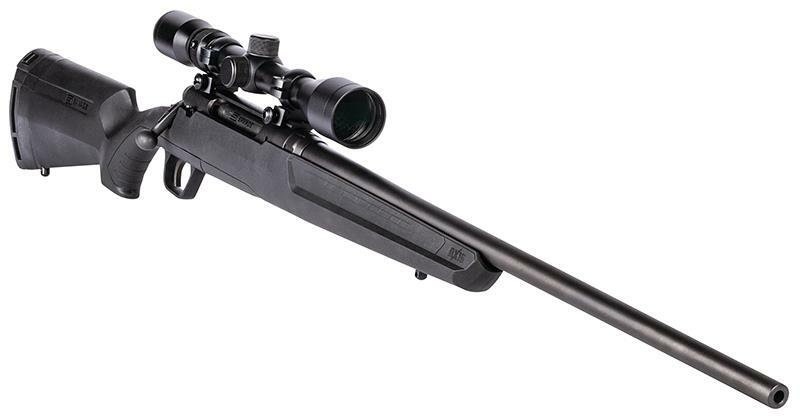
Savage Axis XP 308 is a hunting rife that has been used by many hunters for its accuracy and stealth, it’s also less than $500 which makes this gun very affordable.
How To Choose The Best Hunting Rifle for Bear:
Some people think that you need to buy the most expensive, most powerful hunting rifle in order to hunt bear effectively – but they’re wrong! There are many rifles on the market that will do just as well if not better than more expensive ones.
When choosing your new hunting rifle there are many different factors to consider such as budget , type of hunting, and weight.
Budget: It is important to consider the cost of a bear rifle before deciding on which one to buy, as a rifle could be the most expensive part of your hunting equipment. Ruger offers their Ruger Hawkeye Alaskan for around $500 – $600
Type of Hunting: There are many different types of bears that people hunt in North America such as black bear, brown/grizzly bear, and polar bears. In order to choose the best type of gun for you it is important to know what type of species you will be hunting.
If you plan on hunting all three make sure that you get a gun with interchangeable barrels so that when necessary; this can easily accommodate any weight class with just an additional barrel change
If you are planning to hunt with your rifle for the first time it is very important that you make sure there is enough power behind your shot in order to ensure a kill.
Bears can be found at various elevations so depending on where they live their size will vary – some might only weigh 150 pounds while others may weigh 300+. So before choosing which rifle to buy check out what kind of terrain an animal lives in as well as its average size range.
Weight: It’s also important to consider how much weight you’re willing to carry when selecting a gun because carrying too much extra weight could lead to injury or even death over long distances. Ruger Hawkeye Alaskan weighs in at a little over nine pounds when unloaded so it is the perfect weight for long trekking hikes.
Caliber type: (most hunters prefer .300 win mag), weight of gun, barrel length, etc… It’s important to find what works.
In Ruger Hawkeye Alaskan’s case, they use a Ruger patented rotary-bolt system which is designed to extract each cartridge from the magazine and chamber it without the aid of an ejector. This design has proven to be more reliable than any other type in Ruger’s history while also being easier for users who are left handed or right handed but not ambidextrous!
How about accuracy? If you are looking for accuracy go for the Ruger Hawkeye Alaskan which comes with adjustable sights that can range up to 500 yards so you’re never going to miss your target! The trigger on this rifle is crisp enough as well so you don’t have much room for error when aiming downrange at those bear targets.
Also Read: Best Shooting Rest for Successful Hunting

